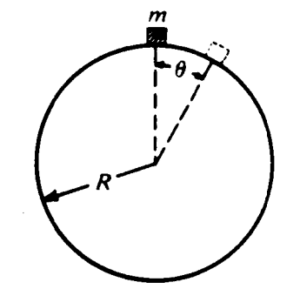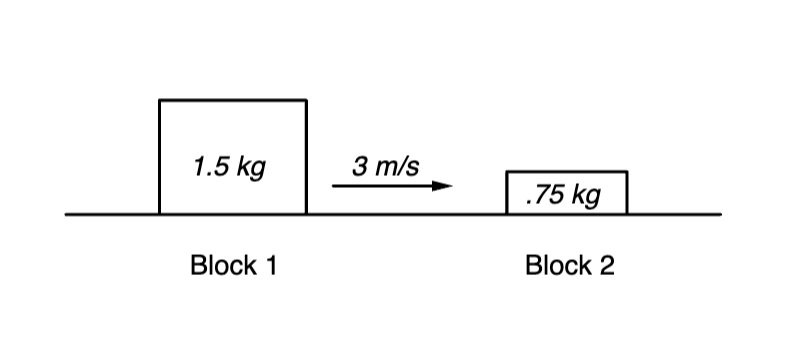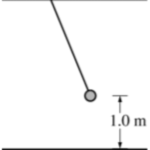0 attempts
0% avg
UBQ Credits
| Derivation/Formula | Reasoning |
|---|---|
| \[ \omega = \sqrt{\frac{k}{m}} \] | This is the formula for the angular frequency of a mass-spring system, where \(k=20.0\,\text{N/m}\) and \(m=1.5\,\text{kg}\). |
| \[ \omega = \sqrt{\frac{20.0}{1.5}} \approx 3.65\,\text{rad/s} \] | Substitute the given values to calculate \(\omega\). |
| \[ f = \frac{\omega}{2\pi} \approx \frac{3.65}{6.28} \approx 0.582\,\text{Hz} \] | Convert the angular frequency to the ordinary frequency using \(f=\omega/(2\pi)\). |
| Derivation/Formula | Reasoning |
|---|---|
| \[ v_{\text{max}} = A\,\omega \] | The maximum speed in simple harmonic motion is the product of the amplitude \(A\) and the angular frequency \(\omega\). |
| \[ v_{\text{max}} = 0.10\,\text{m} \times 3.65\,\text{rad/s} \approx 0.365\,\text{m/s} \] | Substitute the amplitude \(A=0.10\,\text{m}\) and the computed \(\omega\) into the formula. |
| \[ \text{Occurs at } x=0 \] | The maximum speed occurs at the equilibrium position where the displacement is zero. |
| Derivation/Formula | Reasoning |
|---|---|
| \[ a_{\text{max}} = \omega^2\,A \] | The maximum acceleration in simple harmonic motion is given by \(a_{\text{max}}=\omega^2 A\). |
| \[ a_{\text{max}} = (3.65\,\text{rad/s})^2 \times 0.10\,\text{m} \approx 1.33\,\text{m/s}^2 \] | Substitute \(\omega \approx 3.65\,\text{rad/s}\) and \(A = 0.10\,\text{m}\) into the equation. |
| \[ \text{Occurs at } x = \pm 0.10\,\text{m} \] | The magnitude of acceleration is maximum at the extreme positions (\(x=\pm A\)) of the oscillation. |
| Derivation/Formula | Reasoning |
|---|---|
| \[ E = \frac{1}{2}\,k\,A^2 \] | The total mechanical energy in a mass-spring system is stored as potential energy in the spring at maximum displacement. |
| \[ E = \frac{1}{2} \times 20.0\,\text{N/m} \times (0.10\,\text{m})^2 \] | Substitute the given values \(k=20.0\,\text{N/m}\) and \(A=0.10\,\text{m}\) into the energy formula. |
| \[ E = 0.1\,\text{J} \] | Simplify the expression to obtain the total energy of the system. |
| Derivation/Formula | Reasoning |
|---|---|
| \[ x(t) = A\,\cos(\omega t + \phi) \] | This is the general solution for the displacement in simple harmonic motion, where \(\phi\) is the phase constant. |
| \[ x(0) = A\,\cos(\phi) = 0.10\,\text{m} \] | At \(t=0\), the mass is released from rest at \(x=0.10\,\text{m}\), which implies \(\phi = 0\) because \(\cos(0)=1\). |
| \[ x(t) = 0.10\,\text{m}\,\cos\Big(\sqrt{\frac{20.0}{1.5}}\,t\Big) \] | Substitute \(A=0.10\,\text{m}\), \(\omega=\sqrt{\frac{20.0}{1.5}}\), and \(\phi=0\) into the general solution to obtain the displacement as a function of time. |
Just ask: "Help me solve this problem."
 How does the time t1 of a block m reaching the bottom of slide 1 compare with t2, the time taken block of mass 2m to reach the end of slide 2 that’s curved? The blocks are released from the same height.
How does the time t1 of a block m reaching the bottom of slide 1 compare with t2, the time taken block of mass 2m to reach the end of slide 2 that’s curved? The blocks are released from the same height.

A particle of mass m slides down a fixed, frictionless sphere of radius R, starting from rest at the top.
In terms of m, g, R, and O, determine each of the following for the particle while it is sliding on the sphere.
A 90 kg individual is cycling up a hill inclined at 30 degrees on a 12 kg bicycle. The hill is quite steep, and the coefficient of static friction is 0.85. The cyclist ascends 12 meters up the hill and then pauses at the summit. If they then start descending from the peak at rest and travel 9 meters before firmly applying the brakes, causing the wheels to lock.

Block 2 initially is at rest. Block 1 travels towards block 2 and collides with Block 2 as shown above. Find the final velocities of both blocks assuming the collision is elastic.

A 0.5 kg pendulum bob is raised to 1.0 m above the floor, as shown in the figure. The bob is then released from rest. When the bob is 0.8 m above the floor, its speed is most nearly
By continuing you (1) agree to our Terms of Sale and Terms of Use and (2) consent to sharing your IP and browser information used by this site’s security protocols as outlined in our Privacy Policy.
| Kinematics | Forces |
|---|---|
| \(\Delta x = v_i t + \frac{1}{2} at^2\) | \(F = ma\) |
| \(v = v_i + at\) | \(F_g = \frac{G m_1 m_2}{r^2}\) |
| \(v^2 = v_i^2 + 2a \Delta x\) | \(f = \mu N\) |
| \(\Delta x = \frac{v_i + v}{2} t\) | \(F_s =-kx\) |
| \(v^2 = v_f^2 \,-\, 2a \Delta x\) |
| Circular Motion | Energy |
|---|---|
| \(F_c = \frac{mv^2}{r}\) | \(KE = \frac{1}{2} mv^2\) |
| \(a_c = \frac{v^2}{r}\) | \(PE = mgh\) |
| \(T = 2\pi \sqrt{\frac{r}{g}}\) | \(KE_i + PE_i = KE_f + PE_f\) |
| \(W = Fd \cos\theta\) |
| Momentum | Torque and Rotations |
|---|---|
| \(p = mv\) | \(\tau = r \cdot F \cdot \sin(\theta)\) |
| \(J = \Delta p\) | \(I = \sum mr^2\) |
| \(p_i = p_f\) | \(L = I \cdot \omega\) |
| Simple Harmonic Motion | Fluids |
|---|---|
| \(F = -kx\) | \(P = \frac{F}{A}\) |
| \(T = 2\pi \sqrt{\frac{l}{g}}\) | \(P_{\text{total}} = P_{\text{atm}} + \rho gh\) |
| \(T = 2\pi \sqrt{\frac{m}{k}}\) | \(Q = Av\) |
| \(x(t) = A \cos(\omega t + \phi)\) | \(F_b = \rho V g\) |
| \(a = -\omega^2 x\) | \(A_1v_1 = A_2v_2\) |
| Constant | Description |
|---|---|
| [katex]g[/katex] | Acceleration due to gravity, typically [katex]9.8 , \text{m/s}^2[/katex] on Earth’s surface |
| [katex]G[/katex] | Universal Gravitational Constant, [katex]6.674 \times 10^{-11} , \text{N} \cdot \text{m}^2/\text{kg}^2[/katex] |
| [katex]\mu_k[/katex] and [katex]\mu_s[/katex] | Coefficients of kinetic ([katex]\mu_k[/katex]) and static ([katex]\mu_s[/katex]) friction, dimensionless. Static friction ([katex]\mu_s[/katex]) is usually greater than kinetic friction ([katex]\mu_k[/katex]) as it resists the start of motion. |
| [katex]k[/katex] | Spring constant, in [katex]\text{N/m}[/katex] |
| [katex] M_E = 5.972 \times 10^{24} , \text{kg} [/katex] | Mass of the Earth |
| [katex] M_M = 7.348 \times 10^{22} , \text{kg} [/katex] | Mass of the Moon |
| [katex] M_M = 1.989 \times 10^{30} , \text{kg} [/katex] | Mass of the Sun |
| Variable | SI Unit |
|---|---|
| [katex]s[/katex] (Displacement) | [katex]\text{meters (m)}[/katex] |
| [katex]v[/katex] (Velocity) | [katex]\text{meters per second (m/s)}[/katex] |
| [katex]a[/katex] (Acceleration) | [katex]\text{meters per second squared (m/s}^2\text{)}[/katex] |
| [katex]t[/katex] (Time) | [katex]\text{seconds (s)}[/katex] |
| [katex]m[/katex] (Mass) | [katex]\text{kilograms (kg)}[/katex] |
| Variable | Derived SI Unit |
|---|---|
| [katex]F[/katex] (Force) | [katex]\text{newtons (N)}[/katex] |
| [katex]E[/katex], [katex]PE[/katex], [katex]KE[/katex] (Energy, Potential Energy, Kinetic Energy) | [katex]\text{joules (J)}[/katex] |
| [katex]P[/katex] (Power) | [katex]\text{watts (W)}[/katex] |
| [katex]p[/katex] (Momentum) | [katex]\text{kilogram meters per second (kgm/s)}[/katex] |
| [katex]\omega[/katex] (Angular Velocity) | [katex]\text{radians per second (rad/s)}[/katex] |
| [katex]\tau[/katex] (Torque) | [katex]\text{newton meters (Nm)}[/katex] |
| [katex]I[/katex] (Moment of Inertia) | [katex]\text{kilogram meter squared (kgm}^2\text{)}[/katex] |
| [katex]f[/katex] (Frequency) | [katex]\text{hertz (Hz)}[/katex] |
General Metric Conversion Chart
Example of using unit analysis: Convert 5 kilometers to millimeters.
Start with the given measurement: [katex]\text{5 km}[/katex]
Use the conversion factors for kilometers to meters and meters to millimeters: [katex]\text{5 km} \times \frac{10^3 \, \text{m}}{1 \, \text{km}} \times \frac{10^3 \, \text{mm}}{1 \, \text{m}}[/katex]
Perform the multiplication: [katex]\text{5 km} \times \frac{10^3 \, \text{m}}{1 \, \text{km}} \times \frac{10^3 \, \text{mm}}{1 \, \text{m}} = 5 \times 10^3 \times 10^3 \, \text{mm}[/katex]
Simplify to get the final answer: [katex]\boxed{5 \times 10^6 \, \text{mm}}[/katex]
Prefix | Symbol | Power of Ten | Equivalent |
|---|---|---|---|
Pico- | p | [katex]10^{-12}[/katex] | 0.000000000001 |
Nano- | n | [katex]10^{-9}[/katex] | 0.000000001 |
Micro- | µ | [katex]10^{-6}[/katex] | 0.000001 |
Milli- | m | [katex]10^{-3}[/katex] | 0.001 |
Centi- | c | [katex]10^{-2}[/katex] | 0.01 |
Deci- | d | [katex]10^{-1}[/katex] | 0.1 |
(Base unit) | – | [katex]10^{0}[/katex] | 1 |
Deca- or Deka- | da | [katex]10^{1}[/katex] | 10 |
Hecto- | h | [katex]10^{2}[/katex] | 100 |
Kilo- | k | [katex]10^{3}[/katex] | 1,000 |
Mega- | M | [katex]10^{6}[/katex] | 1,000,000 |
Giga- | G | [katex]10^{9}[/katex] | 1,000,000,000 |
Tera- | T | [katex]10^{12}[/katex] | 1,000,000,000,000 |
The most advanced version of Phy. 50% off, for early supporters. Prices increase soon.
per month
Billed Monthly. Cancel Anytime.
Trial –> Phy Pro
Try our free calculator to see what you need to get a 5 on the upcoming AP Physics 1 exam.
A quick explanation
Credits are used to grade your FRQs and GQs. Pro users get unlimited credits.
Submitting counts as 1 attempt.
Viewing answers or explanations count as a failed attempts.
Phy gives partial credit if needed
MCQs and GQs are are 1 point each. FRQs will state points for each part.
Phy customizes problem explanations based on what you struggle with. Just hit the explanation button to see.
Understand you mistakes quicker.

Phy automatically provides feedback so you can improve your responses.
10 Free Credits To Get You Started

By continuing you agree to nerd-notes.com Terms of Service, Privacy Policy, and our usage of user data.
NEW! PHY instantly solves any question
🔥 Elite Members get up to 30% off Physics Tutoring
🧠 Learning Physics this summer? Try our free course.
🎯 Need exam style practice questions? We’ve got over 2000.